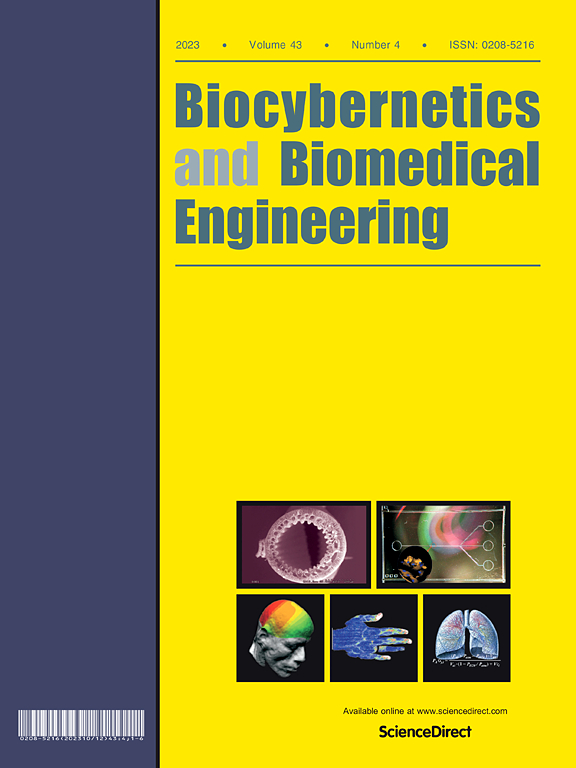Dysphonia discovering using a Goertzel algorithm implementation for vocal signals analysis
IF 6.6
2区 医学
Q1 ENGINEERING, BIOMEDICAL
引用次数: 0
Abstract
Background and objectives: The identification, study and classification of anomalies in vocal signals are used to support physicians in the diagnosis and monitoring of vocal robe pathologies. Dysphonia is the most common disorder causing difficulties in voice production. Dysphonia refers to any impairment in voice quality, and significantly impacts on the quality of life. Early detection is imperative to prevent severe pathologies or to early detect chronic ones. Voice signal processing techniques, such as Fast Fourier Transform (FFT) and Praat, are noninvasive tools used to study phonatory apparatus diseases. Nevertheless there is room for improving efficacy in vocal signal patterns identification that could be related to vocal robe related pathologies.
Methods: The focus is on the possibility of using Goertzel Algorithm (GA) characteristics to improve state of the art for pattern identification in vocal signals. A tool for early identification of dysphonia based on GA is presented. An optimized version of GA, able to detect voice frequency anomalies has been implemented.
Results: The proposed tool has been tested with vocal signal datasets containing both normophonic and pathological subjects. The results are reported in terms of different implementation strategies and techniques. Experimental tests were performed comparing GA based and FFT based signal analysis tools in terms of: (i) efficiency and (ii) capacity of features identification. Performance parameters report: (i) an efficiency in terms of processing time improved by 37 % (i.e. 16.78 ms for FFT vs 12.26 ms for GA) and memory requirements reduced by 74 %; (ii) GA enabled the identification of healthy and pathological conditions better than FFT with a significance level below 0.05.
Conclusions: Results of using GA-based method on vocal signal processing, compared with existing methods, demonstrate the reliability of the proposed method in early identification of dysphonia and in clinical monitoring of patients post treatment.
语音障碍发现使用Goertzel算法实现的声音信号分析
背景与目的:声音信号异常的识别、研究和分类用于支持医生对声带病理的诊断和监测。发音困难是最常见的导致发声困难的障碍。语音障碍是指语音质量的任何损害,并显著影响生活质量。早期发现对于预防严重病变或早期发现慢性病变至关重要。语音信号处理技术,如快速傅里叶变换(FFT)和Praat,是用于研究发声器官疾病的非侵入性工具。尽管如此,在声音信号模式识别方面仍有改进的空间,这可能与声带相关的病理有关。方法:重点是使用Goertzel算法(GA)特征来改进语音信号模式识别的技术状态的可能性。提出了一种基于遗传算法的语音障碍早期识别工具。一个优化版本的遗传算法,能够检测语音频率异常已经实现。结果:提出的工具已经测试了声音信号数据集,包括正常音和病理受试者。根据不同的实现策略和技术报告了结果。实验测试比较了基于遗传算法和基于FFT的信号分析工具在以下方面:(i)效率和(ii)特征识别能力。性能参数报告:(i)处理时间方面的效率提高了37%(即FFT为16.78 ms, GA为12.26 ms),内存需求降低了74%;(ii)与FFT相比,GA能更好地识别健康和病理状况,且显著性水平低于0.05。结论:与现有方法相比,基于ga的语音信号处理方法在语音障碍早期识别和治疗后患者临床监测方面具有较高的可靠性。
本文章由计算机程序翻译,如有差异,请以英文原文为准。
求助全文
约1分钟内获得全文
求助全文
来源期刊

Biocybernetics and Biomedical Engineering
ENGINEERING, BIOMEDICAL-
CiteScore
16.50
自引率
6.20%
发文量
77
审稿时长
38 days
期刊介绍:
Biocybernetics and Biomedical Engineering is a quarterly journal, founded in 1981, devoted to publishing the results of original, innovative and creative research investigations in the field of Biocybernetics and biomedical engineering, which bridges mathematical, physical, chemical and engineering methods and technology to analyse physiological processes in living organisms as well as to develop methods, devices and systems used in biology and medicine, mainly in medical diagnosis, monitoring systems and therapy. The Journal''s mission is to advance scientific discovery into new or improved standards of care, and promotion a wide-ranging exchange between science and its application to humans.
 求助内容:
求助内容: 应助结果提醒方式:
应助结果提醒方式:


